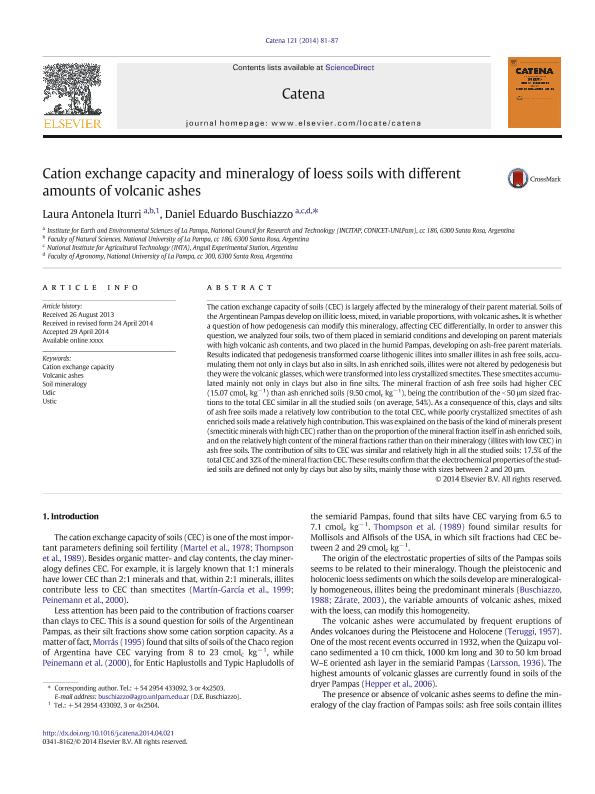Artículo
Cation exchange capacity and mineralogy of loess soils with different amounts of volcanic ashes
Fecha de publicación:
05/2014
Editorial:
Elsevier
Revista:
Catena
ISSN:
0341-8162
Idioma:
Inglés
Tipo de recurso:
Artículo publicado
Resumen
The cation exchange capacity of soils (CEC) is largely affected by the mineralogy of their parent material. Soils of the Argentinean Pampas develop on illitic loess, mixed, in variable proportions, with volcanic ashes. It is whether a question how pedogenesis can modify this mineralogy, affecting CEC differentially. In order to answer this question, we analyzed four soils, two of them placed in semiarid conditions and developing on parent materials with high volcanic ash contents, and two placed in the humid Pampas, developing on ash-free parent materials. Results indicated that pedogenesis transformed coarse lithogenic illites into smaller illites in ash free soils, accumulating them in clays but also in silts. In ash enriched soils, illites were not altered by pedogenesis but they were the volcanic glasses, which were transformed into less crystallized smectites. These smectites accumulated mainly in clays but also in fine silts. The mineral fraction of ash free soils had higher CEC (15.07 cmolc kg-1) than ash enriched soils (9.50 cmolc kg-1), being the contribution of the < 50 μm sized fractions to the total CEC similar in all studied soils (on average, 54 %). As a consequence of this, clays and silts of ash free soils made a relative low contribution to the total CEC, while poorly crystallized smectites of ash enriched soils made a relative high contribution. This was explained on the basis of the kind of minerals present (smectitic minerals with high CEC) rather than on the proportion of the mineral fraction itself in ash enriched soils, and on the relative high content of the mineral fractions rather than on their mineralogy (illites with low CEC) in ash free soils. The contribution of silts to CEC was similar and relatively high in all studied soils: 17.5% of the total CEC and 32% of the mineral fraction CEC. These results confirm that the electrochemical properties of the studied soils are not only defined by clays but also by silts, mainly those with sizes between 2 and 20 µm.
Palabras clave:
Cation Exchange Capacity
,
Volcanic Ashes
,
Soil Mineralogy
,
Udic
,
Ustic
Archivos asociados
Licencia
Identificadores
Colecciones
Articulos(INCITAP)
Articulos de INST.D/CS D/L/TIERRA Y AMBIENTALES D/L/PAMPA
Articulos de INST.D/CS D/L/TIERRA Y AMBIENTALES D/L/PAMPA
Citación
Iturri, Laura Antonela; Buschiazzo, Daniel Eduardo; Cation exchange capacity and mineralogy of loess soils with different amounts of volcanic ashes; Elsevier; Catena; 121; 5-2014; 81-87
Compartir
Altmétricas




